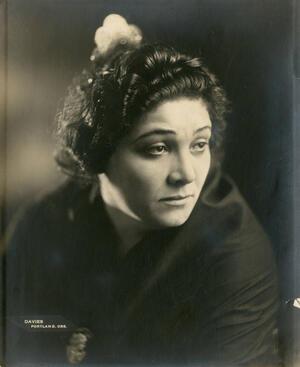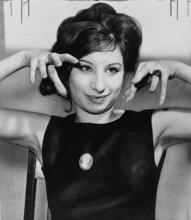Vera Gordon
Vera Gordon began acting at age eleven in Russia and married Nathan A. Gordon, director of the Ostoffersk Acting Company, in 1904, before immigrating to the US in 1905. Once there, Vera Gordon’s career stalled, both from her lack of English and her refusal to join the Yiddish Theater Union. She performed in small venues for several years before moving to England in 1916, where she performed both in vaudeville and mainstream theater. Having rebuilt her career overseas, she made her American film debut in Humoresque in 1920 to rave reviews, playing a mother struggling to raise a family on the Lower East Side. For the next thirty years, she averaged a film a year while continuing to perform on stage, regularly cast as a Jewish mother both in movies and in plays. Her last film, in 1946, was Abie’s Irish Rose.
After her star-making turn in the 1920 film Humoresque, actor Vera Gordon came to represent the archetypical Jewish mother, both on-screen and off. She played mother roles in almost thirty films, including The Millionaires (1926), Four Walls (1928), and the successful The Cohens and the Kellys series. At the same time, she often gave advice on marriage and children to newspapers and magazines, and furthered her nurturing image by supporting children in Jewish orphanages.
Early Life and Career Struggles
Vera Gordon was born Vera Pogorelsky to Boris and Teigan (Nemirovsky) Pogorelsky on June 11, 1886, in Ekaterinoslav, Russia. She began appearing on the Russian stage before age eleven, although at one point the directors of the Shevchenko Imperial Company fired her after learning of her Jewish heritage. In 1904, she married Nathan A. Gordon, a producer and writer at the Ostoffersk Acting Company, with which she was performing. The next year, the couple had a child, William, and immigrated to the United States.
When the Gordons arrived on New York’s Lower East Side with their three-month-old son, neither could speak English. Vera Gordon refused to join the Yiddish Theater Union, believing that her years of experience should count for as much as a union card. This decision cost her the chance to play larger venues, and she appeared instead at smaller houses such the Liberty and the Lyric Theatres. During her struggle to begin her American career, Gordon bore another child, Nadje, in 1907. In 1916, she performed in Britain, appearing first in vaudeville and then in legitimate theater.
Career Success and Impact
In 1919, during her London run in the play Potash and Perlmutter, Paramount Pictures recruited Gordon to star in Humoresque. The film, directed by Frank Borzage, opened the next year to rave reviews. Gordon drew especially good notices for her role as a mother raising her family on the Lower East Side. By age thirty-five, she was a successful movie star, and she averaged almost a film a year for the next three decades. Into that busy schedule she also fit regular stage appearances, often with her daughter. In almost all these roles, Gordon played a mother, although in interviews she always stressed her versatility. The Yiddish theater, she explained, prepared an actor to play any part. She often commented, ironically, that the woman whose name was synonymous with the word “mother” once played an old man, complete with beard.
Gordon moved with her family to Beverly Hills, California, in 1928. Although her heyday was in the 1920s and early 1930s, she continued acting until almost the end of her life, making her last film, Abie’s Irish Rose, in 1946. She died on May 8, 1948, in her Beverly Hills home.
Through her life and work, Vera Gordon put a positive and loving face on the stereotype of the Jewish mother. Despite her rejection of the Yiddish Theater Union, she provided outspoken support of the training the theater itself provided and, during her lifetime, served as an ambassador for both Jewish theater and Jewish culture.
Filmography
Abie’s Irish Rose (1946).
The Big Street (1942).The Cohens and the Kellys, (1926).
The Cohens and the Kellys in Africa (1930).
The Cohens and the Kellys in Atlantic City (1928).
The Cohens and the Kellys in Paris (1928).
The Cohens and the Kellys in Scotland (1930).
Fifty Million Frenchmen (1931).
Four Walls (1928).
Good Provider (1922).
Humoresque (1920).
In Hollywood with Potash and Perlmutter (1924).
Term used for ritually untainted food according to the laws of Kashrut (Jewish dietary laws).Kosher Kitty Kelly (1926); Living Ghost (1942).
Madame Satan (1930).
Michael O’Halloran (1937).
The Millionaires (1926).
North Wind’s Malice (1921).
Potash and Perlmutter (1923).
Private Izzy Murphy (1926).
Sweet Daddies (1926).
When Strangers Meet (1934).
You and Me (1938).
Your Best Friend (1922).
AJYB 24:149, 50:612.
BEOAJ;
Gordon, Vera. Scrapbook. Performing Arts Collection, New York Public Library for the Performing Arts at Lincoln Center.
Katz, Ephraim. Film Encyclopedia (1979).
Stewart, John. Filmrama. Vol. 2, The Flaming Years, 1920–1929 (1977).
Truitt, Evelyn Mack. Who Was Who on Screen (1974).
“Vera Gordon, 61, Screen Actress.” NYTimes, May 10, 1948, 21:4.
Weaver, John T. Forty Years of Screen Credits, 1929–1969 (1970); WWIAJ (1926, 1928).




